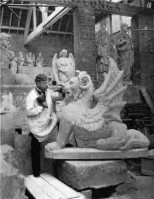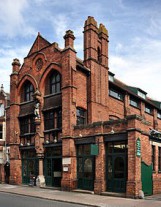
H A R R Y H E M S
On Thursday, 10 April 2014, members learnt from Colin Vosper’s excellent talk about Victorian sculptor and Exeter businessman Harry Hems (1842 - 1916). During his lifetime he was one of the best-known of Exeter's citizens. What a character he was ! And what a sculptor, both in wood and stone.
Whilst working in London on the construction of the new Foreign Office, Hems was lucky (or conniving) enough to meet the world-famous architect Gilbert Scott (later knighted in 1872).
Arriving in Exeter, Hems has described how he picked up a discarded (lucky) horse shoe glinting in the sun whilst trudging up the hill from St. David’s Station. His luck was soon realised when he found work as a sculptor for the new Exeter Museum. Later he struck
lucky again with a commission from Sir Gilbert Scott to restore the oak seating, altar and pulpit at St John’s Church, Stowford. The excellent quality of his workmanship was noted in the press and this publicity greatly boosted his business.
As Hems’ business expanded, the firm moved from Paris Street to architect-designed studios in Longbrook Street. The front of the building still displays that “Luckie Horseshoe” and features sandstone and marble ostentatiously imported from Scotland. From his office, through an internal window he could check that his staff were not slacking - in fact, Hems once found himself in court for attacking a member of staff who was!
Yet Hems was benevolent to his staff. He sponsored the ‘Annual Walking Race’ from Exeter to Exmouth (for their health) and arranged staff outings and celebration meals. He even provided coffins for deceased staff, quipping that it was a service provided for those who had “moved on from carving angels to joining them”. Hems was also a great benefactor of the poor and for many years held Christmas lunches for the elderly poor, inviting as many each year as his age.
Hems was an ecclesiastical sculptor inspired by Gothic architecture. His large workshop in Exeter produced woodwork and sculpture for churches all over the country and abroad. By 1879 more than 400 churches and 100 public buildings contained his work. His sculptures can be found in Australia, Canada, America and all over the UK – and particularly in Paignton, Torquay, Harberton, Cockington and at the RAMM in Exeter.
His brick-built workshop (right) has been described variously as "'domesticated' or "gothic styled but with several peculiar additions". It extends over three floors and has a circular window in the gable facing the road. This incorporates Hems's monogram. By 1895, Hems employed over a hundred craftsmen plus staff in London, Oxford and Ireland.
However, he neglected to pay his taxes and some of his work was auctioned to pay off his unpaid tax. His humour shows through in that these items included:
- a life-sized statue of St Matthew the Tax Gatherer
- the crowbar the bailiffs used to gain entry to his workshop
- three second-hand tombstones listed by Hems as “suitable for the graves of Income Tax Commissioners", and
- a sculpture of the Twelve Apostles (Hems made much of the way the Twelve Apostles were having to pay his income tax!)
Colin’s book on Harry Hems is available from Torquay Museum and contains an extensive summary of his life and works.
His brick-built workshop in Longbrook Street (left, now a restaurant called "Harry's") has been described variously as "'domesticated' or "gothic styled but with several peculiar additions". It extends over three floors and has a circular window in the gable facing the road. This incorporates Hems's monogram. By 1895, Hems employed over a hundred craftsmen plus staff in London, Oxford and Ireland.
However, he neglected to pay his taxes and some of his work was auctioned to pay off his unpaid tax. His humour shows through in that these items included:
- a life-sized statue of St Matthew the Tax Gatherer
- the crowbar the bailiffs used to gain entry to his workshop
- three second-hand tombstones listed by Hems as “suitable for the graves of Income Tax Commissioners", and
- a sculpture of the Twelve Apostles (Hems made much of the way the Twelve Apostles were having to pay his income tax!)
Colin’s book on Harry Hems is available from Torquay Museum and contains an extensive summary of his life and works.


